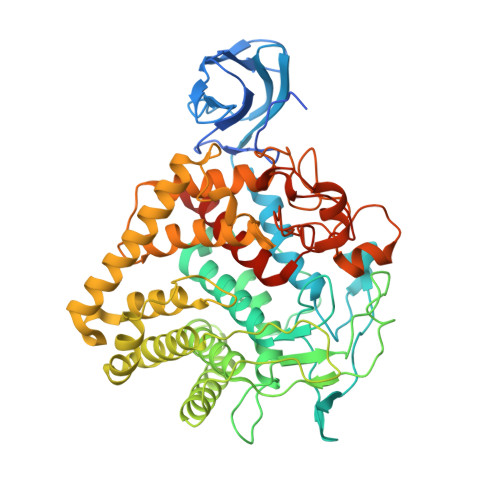Polarity Alteration of a Calcium Site Induces a Hydrophobic Interaction Network and Enhances Cel9A Endoglucanase Thermostability.
Wang, H.J., Hsiao, Y.Y., Chen, Y.P., Ma, T.Y., Tseng, C.P.(2016) Appl Environ Microbiol 82: 1662-1674
- PubMed: 26729722
- DOI: https://doi.org/10.1128/AEM.03326-15
- Primary Citation of Related Structures:
5E2J - PubMed Abstract:
Structural calcium sites control protein thermostability and activity by stabilizing native folds and changing local conformations. Alicyclobacillus acidocaldarius survives in thermal-acidic conditions and produces an endoglucanase Cel9A (AaCel9A) which contains a calcium-binding site (Ser465 to Val470) near the catalytic cleft. By superimposing the Ca(2+)-free and Ca(2+)-bounded conformations of the calcium site, we found that Ca(2+) induces hydrophobic interactions between the calcium site and its nearby region by driving a conformational change. The hydrophobic interactions at the high-B-factor region could be enhanced further by replacing the surrounding polar residues with hydrophobic residues to affect enzyme thermostability and activity. Therefore, the calcium-binding residue Asp468 (whose side chain directly ligates Ca(2+)), Asp469, and Asp471 of AaCel9A were separately replaced by alanine and valine. Mutants D468A and D468V showed increased activity compared with those of the wild type with 0 mM or 10 mM Ca(2+) added, whereas the Asp469 or Asp471 substitution resulted in decreased activity. The D468A crystal structure revealed that mutation D468A triggered a conformational change similar to that induced by Ca(2+) in the wild type and developed a hydrophobic interaction network between the calcium site and the neighboring hydrophobic region (Ala113 to Ala117). Mutations D468V and D468A increased 4.5°C and 5.9°C, respectively, in melting temperature, and enzyme half-life at 75°C increased approximately 13 times. Structural comparisons between AaCel9A and other endoglucanases of the GH9 family suggested that the stability of the regions corresponding to the AaCel9A calcium site plays an important role in GH9 endoglucanase catalysis at high temperature.
Organizational Affiliation:
Department of Biological Science and Technology, National Chiao Tung University, Hsinchu, Taiwan, Republic of China.

















